Nicholson File Anderson
Return to: Industrial History Page

|
The original building was built by the Arcade File Works The Arcade File Works was incorporated 1892, capital stock $50,000, S. W. Alierton pres, C. C. Clarke v-pres and treas, Andrew Finegan supt. From "What Everyone Wants to Know About Anderson Ind. And the Gas Belt" 1891. Arcade File Works, from Sing Sing, New York; employ 200 men; capital $200,000.00. |
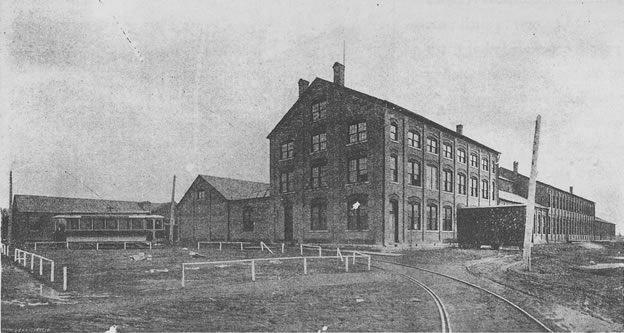
|
| THE ARCADE FILE WORKS WANT THE TOWN'S NAME CHANGED.
The Arcade File Works of Sing Sing have recently been prospecting with a view to locating In some other place, partly owing to the fact that as their goods are manufactured "in Sing Sing" it is hard to make dealers understand that they are not made in the prison, and partly because their works are getting too small, and, being situated some distance from the railroad, their cartage expenses are very high. These facts, together with the information that one or two offers of $50,000 had been made the works from other places to come to them, set the Sing Sing Board of Trade to work to try and retain the industry if possible. To a committee appointed for the purpose, the company gave as its ultimatum that it would consider a proposition to pay them $10,000 in cash to enable them to enlarge their works and that the name of the village must be changed from "Sing Sing" to something not associated with a prison. With these proposals the board is now wrestling. They are about equally divided as to the money item. As to the change of name they do not know whether that can be done, and it would have to be done anyway by the Legislature. This subject of change of name has heretofore received attention, the plan being to let the prison retain the name of Sing Sing and change the village's name to Ossining, the tow name, or some other one. The file works, however, object to Ossining, as it is a near relation to prison. The New York Times January 7, 1891 |
Nicholson File cane to Anderson in 1900, taking over the old Arcade File Works.
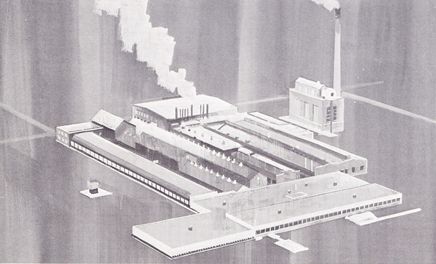
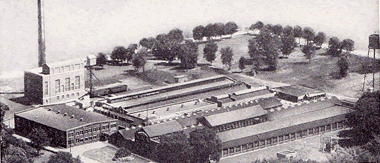
HISTORIC SKETCH of the main plant and general executive offices of the
Nicholson File Company are located a short distance from the center of the city of Providence. They are of
thoroughly modern construction, well lighted and ventilated, and designed especially for the manufacture of files.
They are equipped with special machines and appliances, the principles of which were conceived by Mr. William T.
Nicholson, the founder of the Nicholson File Company and the successful developer of the machine-file-making industry.
Mr. Nicholson's early business experience was in the machine tool business, where he developed the idea of constructing a file cutting machine. As he progressed with his new idea he became greatly enthused over the possibilities of such a machine and in order to be thoroughly informed regarding the file industry went to Europe which at that time supplied most of the files used in America. There he studied not only the manufacture and use of files but also such kindred industries as the manufacture and heat treatment of steel, and he returned only when he felt sufficiently informed on the subject to establish his own file factory.
In 1864 the Nicholson File Company was incorporated and its first plant erected immediately at Providence. It was hoped at the time that a daily production of 300 dozen files might be reached, but business was not easily obtained. Several similar enterprises were attempting to cut files by machine, and the resulting products were of very inferior quality and were being offered by makers of hand cut files as convincing examples of the failure of file cutting by machinery.
The superior quality of the new Nicholson Files gradually became an acknowledged fact, the antagonism towards machine cut files diminished, and the output of the works slowly increased until over three hundred dozen files a day; were being manufactured. Nicholson Files in a few years had become the standard in America, and hand cut files were a thing of the past.
In 1870 the first of a series of very, complete catalogs was published, and in 1878 Mr. Nicholson wrote a treatise on files and heir groper selection and use, which as "File Filosophy" is now in the second printing of its seventeenth edition.
Mr. Nicholson, at the time of his death in October 1893, had seen the output of his works increased to over 1500 dozen files daily, and he had established an organization which has since developed the Company until it now operates four large plants in the United States and Canada which turn out thousands of dozens of files a day.
Colonel Samuel M. Nicholson, son of the founder, devoted his entire business life to the manufacture of files and managed the Company from 1893 to the time of his death in 1939. Under his leadership the Nicholson File Company became the largest company in the world manufacturing exclusively Files and Rasps. Whereas the founder was a pioneer in the science of cutting files by machinery, Colonel Nicholson was a pioneer exporter of files and as a result Nicholson Files are to be found in every market of the world.
Mr. Paul C. Nicholson, who had been active in the Company since 1911, was elected President and General Manager in 1939. It is Mr. Nicholson who has guided the organization through the difficult years of World War II and the Post War Period and who has been responsible for the position the Company has maintained in Domestic and Export Markets.
On April 21, 1952, Mr. Paul C. Nicholson was elected Chairman of the Board of Directors and his son, Mr. Paul C. Nicholson, Jr., was elected President and General Manager, thus becoming the fourth generation in active charge of the Company's affairs. Mr. Nicholson, Jr., joined the Company in 1941 and served as Secretary from 1948 to 1952.
The principal factory of the Company is located at Providence and large branch factories are at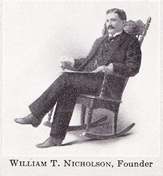 Philadelphia, Pa., Anderson, Indiana, and Port Hope, Ontario. At the Providence factory are manufactured the full
lines of Nicholson, and Black Diamond Brands of Files and Rasps, a complete line of Nicholson X.F. Swiss Pattern
Files and various associated products such as File Handles, Holders, and Cleaners. Nicholson and Black Diamond
Files and Rasps and Nicholson X. F. Swiss Pattern Files represent the very highest quality product of this Company.
Philadelphia, Pa., Anderson, Indiana, and Port Hope, Ontario. At the Providence factory are manufactured the full
lines of Nicholson, and Black Diamond Brands of Files and Rasps, a complete line of Nicholson X.F. Swiss Pattern
Files and various associated products such as File Handles, Holders, and Cleaners. Nicholson and Black Diamond
Files and Rasps and Nicholson X. F. Swiss Pattern Files represent the very highest quality product of this Company.
The manufacture of Nicholson X. F. Swiss Pattern Files was first started in 1893 and is carried on in a thoroughly modern plant equipped with the finest tools and machinery to assure the production of Swiss Pattern Files of a quality that will give entire satisfaction to the exacting requirements of jewelers, watch makers and fine tool makers.
The Philadelphia and Anderson plants continue to manufacture brands well known throughout the country for over fifty years: American, Arcade, Eagle, Great Western, Kearney &Foot, McClellan and J. Barton Smith.
Our Canadian Plant manufactures Black Diamond, Globe, Arcade, Great Western and Kearney & Foot brand files.
Mr. Nicholson's early business experience was in the machine tool business, where he developed the idea of constructing a file cutting machine. As he progressed with his new idea he became greatly enthused over the possibilities of such a machine and in order to be thoroughly informed regarding the file industry went to Europe which at that time supplied most of the files used in America. There he studied not only the manufacture and use of files but also such kindred industries as the manufacture and heat treatment of steel, and he returned only when he felt sufficiently informed on the subject to establish his own file factory.
In 1864 the Nicholson File Company was incorporated and its first plant erected immediately at Providence. It was hoped at the time that a daily production of 300 dozen files might be reached, but business was not easily obtained. Several similar enterprises were attempting to cut files by machine, and the resulting products were of very inferior quality and were being offered by makers of hand cut files as convincing examples of the failure of file cutting by machinery.
The superior quality of the new Nicholson Files gradually became an acknowledged fact, the antagonism towards machine cut files diminished, and the output of the works slowly increased until over three hundred dozen files a day; were being manufactured. Nicholson Files in a few years had become the standard in America, and hand cut files were a thing of the past.
In 1870 the first of a series of very, complete catalogs was published, and in 1878 Mr. Nicholson wrote a treatise on files and heir groper selection and use, which as "File Filosophy" is now in the second printing of its seventeenth edition.
Mr. Nicholson, at the time of his death in October 1893, had seen the output of his works increased to over 1500 dozen files daily, and he had established an organization which has since developed the Company until it now operates four large plants in the United States and Canada which turn out thousands of dozens of files a day.
Colonel Samuel M. Nicholson, son of the founder, devoted his entire business life to the manufacture of files and managed the Company from 1893 to the time of his death in 1939. Under his leadership the Nicholson File Company became the largest company in the world manufacturing exclusively Files and Rasps. Whereas the founder was a pioneer in the science of cutting files by machinery, Colonel Nicholson was a pioneer exporter of files and as a result Nicholson Files are to be found in every market of the world.
Mr. Paul C. Nicholson, who had been active in the Company since 1911, was elected President and General Manager in 1939. It is Mr. Nicholson who has guided the organization through the difficult years of World War II and the Post War Period and who has been responsible for the position the Company has maintained in Domestic and Export Markets.
On April 21, 1952, Mr. Paul C. Nicholson was elected Chairman of the Board of Directors and his son, Mr. Paul C. Nicholson, Jr., was elected President and General Manager, thus becoming the fourth generation in active charge of the Company's affairs. Mr. Nicholson, Jr., joined the Company in 1941 and served as Secretary from 1948 to 1952.
The principal factory of the Company is located at Providence and large branch factories are at
 Philadelphia, Pa., Anderson, Indiana, and Port Hope, Ontario. At the Providence factory are manufactured the full
lines of Nicholson, and Black Diamond Brands of Files and Rasps, a complete line of Nicholson X.F. Swiss Pattern
Files and various associated products such as File Handles, Holders, and Cleaners. Nicholson and Black Diamond
Files and Rasps and Nicholson X. F. Swiss Pattern Files represent the very highest quality product of this Company.
Philadelphia, Pa., Anderson, Indiana, and Port Hope, Ontario. At the Providence factory are manufactured the full
lines of Nicholson, and Black Diamond Brands of Files and Rasps, a complete line of Nicholson X.F. Swiss Pattern
Files and various associated products such as File Handles, Holders, and Cleaners. Nicholson and Black Diamond
Files and Rasps and Nicholson X. F. Swiss Pattern Files represent the very highest quality product of this Company.The manufacture of Nicholson X. F. Swiss Pattern Files was first started in 1893 and is carried on in a thoroughly modern plant equipped with the finest tools and machinery to assure the production of Swiss Pattern Files of a quality that will give entire satisfaction to the exacting requirements of jewelers, watch makers and fine tool makers.
The Philadelphia and Anderson plants continue to manufacture brands well known throughout the country for over fifty years: American, Arcade, Eagle, Great Western, Kearney &Foot, McClellan and J. Barton Smith.
Our Canadian Plant manufactures Black Diamond, Globe, Arcade, Great Western and Kearney & Foot brand files.
NICHOLSON FILE COMPANY
William T. Nicholson, Founder
William T. Nicholson, Founder
 .pdf File |
The information above was copied from a Nicholson File X.F. Swiss pattern file pamphlet
dated 1956 at the Anderson Library. |
New Nicholson File Addition In Use
| Executives of the local Nicholson File plant and visiting officials are pictured above on a plant tour of inspection of the Anderson plant’s new addition which is now in operation. Left to right are John H Burton Sr., Providence, vice president in charge of engineering, and John H. Burton Jr., manager of the Anderson plant. |
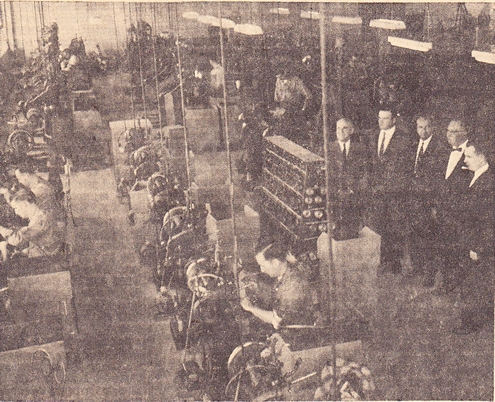 |
One of the largest industrial expansion projects carried out here in recent years is construction of a new $1,000,000 addition to the Nicholson File plant, to provide facilities for transfer of manufacturing operations at the parent plant of the company in Providence R.I., to Anderson.
Decision was made last year by the Nicholson firm to move from Providence to Anderson. The decision was followed by a Chamber of Commerce dinner at which honor was paid to Nicholson executives, including Paul Nicholson Jr., president; Blair LeFever, vice president in charge of engineering, and Stanley Livingston, vice president in charge of operations.
John H. Burton Sr., assistant vice president in charge of operations, and John Burton Jr., general manager of the Anderson plant, were active at the dinner and have been prominent in building the large new addition.
The Nicholson plant, which employed around 500, will have a force of over 800 in the new enlarged plant, Floor space of the industry is increased 40 per cent through erection of the new building.
The new structure with 55,000 square feet of floor space, has frontage of 450 feet on 36th St. and extended 125 feet north and south adjoining older parts of the industry.
First unit of the new addition placed in Operation was the extra fine cutting unit. The next department placed in operation was the American pattern cutting department. The largest operation started was the grinding department, where heavier machinery is operated.
Completion of the new building gives Anderson the largest file making plant in the country.
ANDERSON DAILY BULLETIN 6/22/59
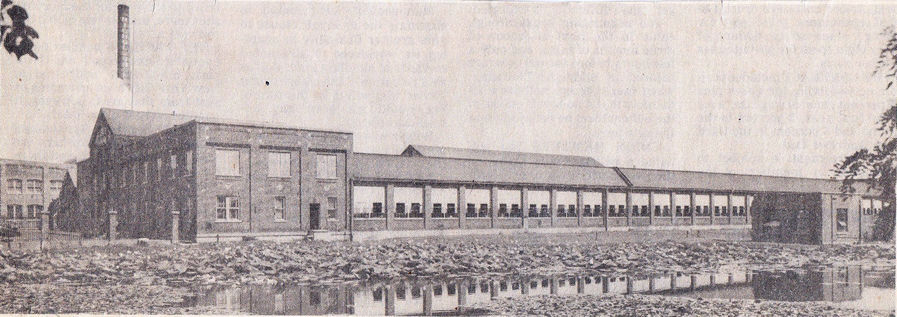
‘The file shop' will be all but closed by Aug. 31
Doomsday at Nicholson File
Doomsday at Nicholson File
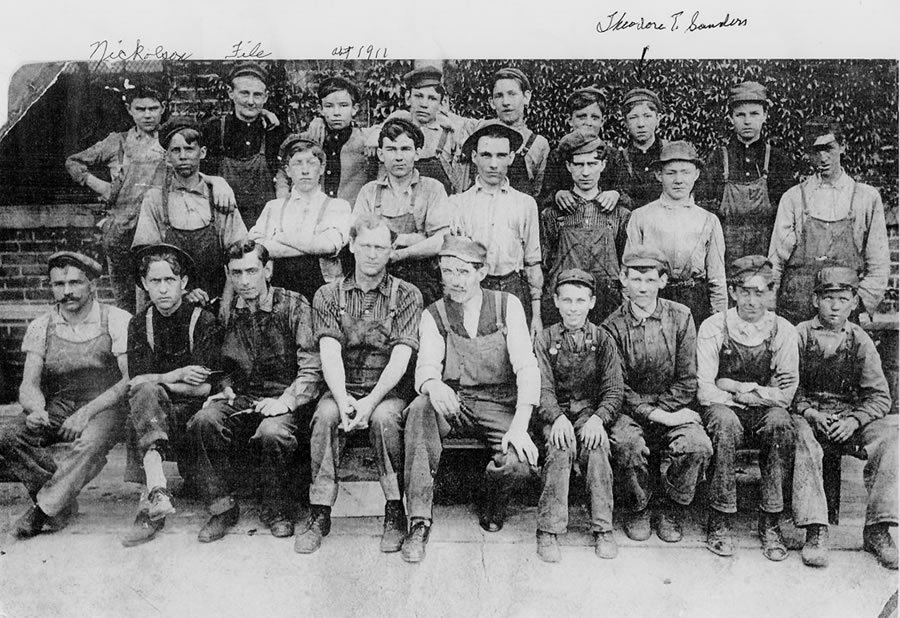
By G.K. HAWES
Herald staff writer
One of Anderson's oldest industries will be little more than a memory by the end of next month.
Nicholson File Company reportedly began a phase down more than a week ago which will see the labor force cut to 80 skilled workers within six weeks. At least 200 of the more than 400 employees have already lost their jobs.
GENERAL MANAGER Raymond P. Sokol confirmed the report in a telephone interview Friday. The 39 year Anderson resident said that shortly after the Aug. 31 deadline he and most of the plant's local operations would be headquartered in Cullen, Ala.
The only remnant of a factory Which 10 years ago employed 1,000 persons will be a small force manufacturing machines for foreign plants. He said those employees would be kept on indefinitely.
“It’s just a pretty sad situation ,” said Ralph Crye, president of United Steel Workers Local 1944. "It's just really sad."
AN EMPLOYEE who lost his job last week told The Herald employees began seeing signs of the imminent closing in June.
When we saw the machines start moving out," he said "we knew it was over. It was just a matter of time."
Crye said the official word came about two weeks ago. People began losing their jobs that same week.
AMONG THE first to go were the nine employees who had shaped "extra fine" files by hand. This is the same group that sued both the company and the steelworkers union in late June.
Their department was the first to be moved out when the firm began its gradual transition southward last fill. The nine workers lost their jobs for a time but were later called back.
The company's closing date was delayed. Management said it was because a competitor had gone on strike, creating more demand for Nicholson products. The union, on the other hand, claimed it was because of a lack of production in the firm's new southern facility.
BUT FOR whatever the reason, the nine workers were given new jobs, They sued the company last month, however, because they said a promise to restore their seniority rights was not kept. The union was also sued for what they termed a failure to adequately press a grievance.
Attorney Marion Withers, who filed the suit, said the latest developments will not change his clients' claim. The only possible effect, he said, would come in the amount of the award they could recover.
The litigation, Withers said, is still in the preliminary stages. The only real development, he said, was a request by union attorneys for their case to be moved to federal court.
MEANWHILE, more than 300 persons some already out of a job, are looking for work. Crye said the local union hasn't yet, and probably won't, help in the search.
"I think that's a job for the international union,” he said.
The former worker who spoke to The Herald Friday said he's still looking. He said he's hoping for a job at Delco-Remy.
"I'M NOT very happy," he said. "It looks pretty doggone bad when you give 18 years of your life to a place -- planning your future around working there -- and they just up and move it out from under you."
Some of the persons who will soon be out of a job, he said, had been working at "the file shop" for well over 30 years.
"None of us really know what we're gonna do," he said. "It's just hard to know."
Nicholson File cane to Anderson in 1900, taking over the old Arcade File Works. Arcade moved to town 11 years earlier, coming from Sing Sing, N.Y to (Continued on Page 3)